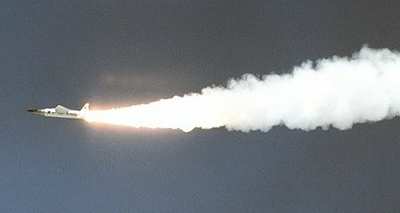Wed, Sep 29, 2004
Next Step: Mach 10 Free Flight
 NASA aeronautics researchers are
looking forward to flying the X-43A research aircraft at speeds up
to 10 times the speed of sound later this fall, following a
successful "captive carry" dress rehearsal flight from NASA's
Dryden Flight Research Center Sept. 27.
NASA aeronautics researchers are
looking forward to flying the X-43A research aircraft at speeds up
to 10 times the speed of sound later this fall, following a
successful "captive carry" dress rehearsal flight from NASA's
Dryden Flight Research Center Sept. 27.
According to X-43A lead operations engineer David McAllister,
who served as test director for the mission, the captive carry
flight duplicated all operational functions of the planned
7,000-mph - or Mach 10 - flight and served as a training exercise
for staff, except that the X-43A and its modified Pegasus booster
were not released from NASA's B-52B launch aircraft and their
engines were not ignited.
"We have two primary purposes for doing a captive carry flight,"
said McAllister. "The first is to make sure that the X-43 and its
booster rocket - two highly complex systems - are ready for flight.
The second is to make sure we're well trained. It's a very big
operation (and) we want to make sure that all those people and all
those systems are ready to go."

The X-43A is powered by a revolutionary air-breathing
supersonic-combustion ramjet - or "scramjet" - engine. Scramjet
engines could enable future hypersonic aircraft or space-access
vehicles to either carry a greater payload or be smaller and
lighter, since they would not have to carry large oxidizer tanks as
present-day launch rockets do. If successful, the Mach 10 flight
will break all speed records for an aircraft powered by an
air-breathing engine.
After a review of captive-carry flight data, project engineers
are expected to set a tentative date for the final X-43A flight for
early November.

The X-43A project is part of the Hyper-X hypersonic research
program led by NASA's Aeronautics Research Mission Directorate and
operated jointly by NASA's Langley Research Center, Hampton (VA),
and Dryden Flight Research Center, Edwards (CA). The program aims
to demonstrate air-breathing engine technologies that promise to
increase payload capacity - or reduce vehicle size for the same
payload - for future hypersonic aircraft and reusable space launch
vehicles.
More News
Airplane Bounced About 3 Ft Then Touched Back Down And Then, With No Brakes Applied, The Airplane Began Veering To The Left Analysis: The pilot entered the airport traffic pattern >[...]
Aero Linx: British Microlight Aircraft Association (BMAA) The primary focus within all aviation activity is SAFETY. In all aspects of our sport SAFETY must come first, whether it b>[...]
From SnF25 (YouTube Edition): William Wynne Builds Practical Aircraft Engines on the Corvair Platform Seeking an affordable alternative to the traditional aircraft engine options, >[...]
How To Get A Story On Aero-TV News/Feature Programming How do I submit a story idea or lead to Aero-TV? If you would like to submit a story idea or lead, please contact Jim Campbel>[...]
From 2023 (YouTube Edition): Bridge of CiES CiES Inc. is a Bend, Oregon-based designer and manufacturer of modular embedded aircraft systems and sensors. The company’s fuel-l>[...]
 NTSB Final Report: Aviat A1
NTSB Final Report: Aviat A1 ANN's Daily Aero-Linx (07.08.25)
ANN's Daily Aero-Linx (07.08.25) Classic Aero-TV: Fly Corvairs Reliable Engine Alternative
Classic Aero-TV: Fly Corvairs Reliable Engine Alternative ANN FAQ: Contributing To Aero-TV
ANN FAQ: Contributing To Aero-TV Classic Aero-TV: CiES Fuel-Quantity and e-Throttle Systems Praised
Classic Aero-TV: CiES Fuel-Quantity and e-Throttle Systems Praised





